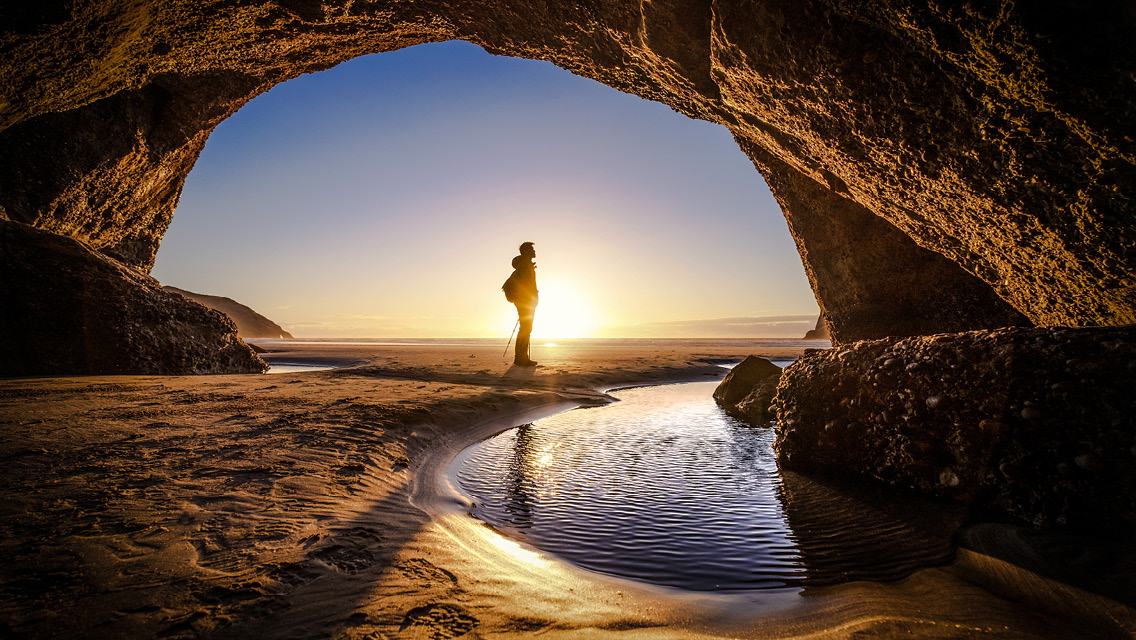Soon after the release of her guide book, 75 Scrambles In Washington: Classic Routes to the Summits (Mountaineers Books, 2001), Dr. Peggy Goldman led a group up Washington’s Mount Rainier on one of the many routes that culminate at the top of the famous peak. Tagging along with the group was a reporter from the Seattle Times who, although an experienced hiker, had never ventured into that gray area between hiking and technical climbing known as “scrambling.”
Before they reached the top, the group needed to tackle a couple of short but challenging rock shelves. Ropes weren’t needed to ascend the vertical sections, but some awkward, groping steps were required, and the exposure of the rock made the possibility of a short fall very real.
“We saw him really push his level of skill to the limit,” said Goldman of the rookie scrambler, “but once he made it, he was very happy with himself.”
At the summit, the group took in the unparalleled vistas of the mountains that dot the Pacific Northwest, including peaks like Mount Adams and the infamous Mount St. Helens. It’s exhilarating views like these, combined with the adrenaline-washed sense of accomplishment, that are scrambling’s finest rewards.
Mountains and Molehills
Affectionately known as “The Mountain” to Washington residents, Mount Rainier is a landmark as visible and recognizable as the Space Needle. On a clear day, the giant peak looms ominously south of the Seattle area. Only a short drive away, it’s an excellent choice for single- or multi-day trips to the summit. Many routes to the top are technically challenging and require advanced skills in climbing and rope technique, but with the right knowledge and appropriate gear, the summit is also accessible via several scrambling routes.
Scrambling is a step up from hiking into the world of mountaineering. A hike technically becomes a scramble when the use of your hands becomes necessary to continue moving upward. These rewarding off-trail excursions offer an interesting and alternate route to the top of many popular hills and mountains. Participants traverse over a variety of rock features, such as boulders, scree fields and vertical shelves.
Routes that scramblers venture onto are liberally covered with big holds for your hands and feet, allowing steady and secure movement upward, and the challenging vertical sections are usually very short. Hands are used a lot when maneuvering over steep rocks and traversing narrow ridges. Ropes are used occasionally over exposed rock to protect participants from injury, but generally confidence, some prior hill experience and a good head for heights are the basic requirements to complete a good scramble.
Mount Rainer appeals to both scramblers and technical mountaineers alike because of its pristine conditions (thanks to the very dedicated Park Service), its variety of terrain, and its accessibility. Roads from the base of the mountain will take you to the Paradise Ranger Station (5,400-foot elevation), which makes one-day summit climbs very doable.
Routes starting at Paradise begin in lush meadows and take scramblers through boulder fields, around the Nisqually glacier and up past the snowline (and there may be deep snow, depending on conditions, even late into the summer). The views constantly change, with more of the surrounding peaks becoming visible the higher you go. (Remember to not get so fixated on reaching your goal that you forget to stop, turn around, and enjoy the rewards of your hard work.)
Making Your Way
Basic rock-climbing and route-finding skills are good things to develop before venturing into scrambling. Guide books like Dr. Goldman’s can provide the latter, with information such as mileage, elevation gain, maps and a route-rating system based on how strenuous and technical a particular route is. Weather, usage and rockfall can drastically change the rating of any route, especially in the Northwest where wet conditions are the norm.
Conditions at Mount Rainier can be particularly difficult to gauge as the mountain can create its own weather and can disappear into the clouds for days (or even weeks) at a time. The best rule is to contact the local park service or Ranger station to check the conditions of any given route before hitting the trail.
As for rock-climbing skills, some people are lucky enough to have climbing friends who will show them the technical skills of rope work and practical climbing. Others who wish to advance quickly and with greater safety should consider a scrambling course from a guide or instructor. Although few Washington-area outfitters provide guided trips up the mountain, the skills required to scramble safely can be learned from a scrambling class at an outfitter or climbing gym in your own area.
A quality course should include: climbing techniques, both up and down; beginning and advanced rope work; retreating and abseiling skills; how to pack essential items; and how to judge weather and route conditions. Vertical Endeavors in St. Paul offers an excellent basic safety course. Check them out at www.verticalendeavors.com.
A lot of the gear used in advanced mountaineering and rock climbing isn’t necessary to complete most entry- to mid-level scrambles, but there are certain things one should have before beginning. Sturdy, waterproof boots with good ankle support are a must. You’ll also want clothing to protect you from minor scrapes and bruises as well as inclement weather, sunglasses and sunscreen, and a helmet to protect your noggin when rockfall is possible (and on most scrambles, rockfall is always possible).
At first glance many popular scrambling routes may appear daunting, but most routes are tackled with relative ease, taking the scrambler through spectacular rock scenery and often finishing at the top of a beautiful summit. Once you begin to venture on to more challenging routes, where the chance of a dangerous fall increases, it’s important to learn how to use a rope and belay a partner safely. Equally important to consider are descending skills like downclimbing and abseiling. A safe scrambler is someone with a background in these essential skills, able to cope with rock-climbing situations such as loose and slippery rock, and not afraid to decide that conditions render a route unsafe.
Due to harsh winter conditions, routes from the Paradise station are closed from October until early May, and those hitting the trails in early spring have to contend with a good deal of snow. On one of my own trips up Mount Rainier in late May I hiked along with a group of snowboarders carrying their boards and wearing snowboard boots all the way to Muir Camp (10,188-foot elevation). They then strapped on their boards and were able to ride a line down the mountain that took them right to the parking lot at Paradise.
Many people who choose to climb the mountain early in the season bring along snowshoes and hiking poles to make the going easier. Once the thaw sets in, the meadows are host to a multitude of sub-alpine wildflowers and wildlife. Other routes up the mountain take you over glacier fields and up 20- to 30-degree ice slopes, requiring the use of ropes and even ice axes. But that is another article.
If you’re yearning for your first scramble, all you need is some decent footwear, a strong heart and the desire to move up in the world.
Washington Scramble Zones
Olympic National Park: Often referred to as “three parks in one,” Olympic National Park is host to three distinct ecosystems: glacier-capped mountains; 30 miles of Pacific coast; and lush old-growth and temperate rainforests. The park is located on the west side of Puget Sound, about a half-day’s drive from Seattle.
North Cascades National Park: Jagged peaks, deep valleys, cascading waterfalls, over 300 glaciers, and lots and lots of scrambling routes. Once again, about a half-day’s journey from Seattle.
Pasaytan Wilderness: Located in the eastern part of the state (four hours east of Seattle), Pasaytan is a true wilderness area with no traffic or automated devices allowed (including chainsaws). The routes located here are easy to navigate, offer spectacular views, and unlike the western part of the state, tend to be dry.
Gear Up
Here’s what you’ll need to reach the top safely and comfortably:
- Tough, waterproof boots with ankle support. When snow is expected, bring gaiters.
- Gloves: leather gardening gloves are sufficient protection. Save your Gore-Tex gloves for keeping your hands warm.
- Sunglasses and sunscreen
- Rock helmet
- Map and compass (and the knowledge to use them properly)
- Protective clothing (to guard against minor scrapes and falls as well as inclement weather
- Extra food and water
Lingo
Scree Field: An open section full of gravel and boulders of various sizes
“Rock!”: What you MUST yell should you ever dislodge a rock or boulder before it falls on those below you. It is your responsibility to protect your fellow scramblers.
Abseiling: More commonly known as belaying. The act of lowering yourself or a partner down a vertical route using a rope.
Slab: A sloped section of rock, not perfectly vertical, but challenging none the less.


This Post Has 0 Comments